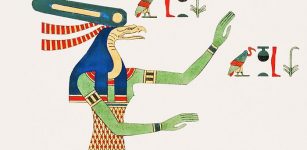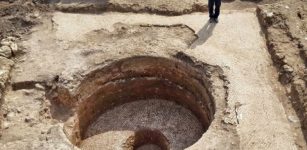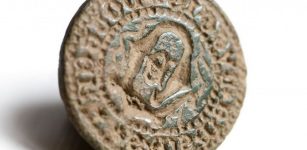Utnapishtim And The Babylonian Flood Story
Ellen Lloyd - AncientPages.com - The ancient story of the great Flood has been re-told worldwide. We find accounts of the event among many ancient cultures all across the world. They all have myths and legends describing a time in the distant past when a horrifying Deluge wiped almost all life on Earth.
The story of Noah’s Ark is not just a Biblical story. Noah was known under a different name in India, among ancient Egyptians and Native Americans, to mention a few cultures.
The life of Utnapishtim and the Babylonian Flood Story are described in the Epic of Gilgamesh. Just like Noah, Utnapishtim is the survivor of the Deluge. Gilgamesh is the semi-mythic King of Uruk best known from The Epic of Gilgamesh (written c. 2150-1400 BCE) the great Sumerian/Babylonian poetic work.
Memories of an antediluvian (pre-flood) period were preserved throughout Mesopotamia: The Sumerian King List includes antediluvian kings, and reliefs of antediluvian sages known as apkallu, winged and bird-headed creatures lined the walls of Assyrian palaces and remain one of the most iconic forms of Mesopotamian art to this day.
The Chaldean Flood Tablets from the city of Ur in what is now Southern Iraq contain a story that describes how the Babylonian god Enlil had been bothered by the incessant noise generated by humans. To punish people he sends a Deluge to wipe out life on the planet.
The Sumerian god Enki, later known as Ea in Akkadian and Babylonian mythology went against the decision of the rest of the gods and ordered Utnapishtim to abandon his worldly possessions and create a huge ship to be called The Preserver of Life.
The ship was made of solid timber so that the rays of Shamash (the Sun) would not shine in, and of equal dimensions in length and width. God Enki assisted with the design and construction of The Preserver of Life. The building of the ship took five days. The ship’s interior had seven floors, each floor divided into 9 sections, finishing the ark fully on the seventh day.
Knowing that the oncoming flood would wipe out all life on Earth, Utnapishtim was told to quickly take his wife, relatives, some of the villagers, animals along with various grains and seeds and board the ship. The entrance to the ship was sealed once everyone had boarded it.
Utnapishtim spent 12 days on The Preserver of Life. When he finally felt it was safe to open the hatch, he saw the slopes of Mount Nisir, supposedly the mountain known today as Pir Omar near the city Sulaymaniyah in Iraqi Kurdistan. Researchers have speculated the name may mean "Mount of Salvation".
He waited seven days before he sent a dove out to see if the water had receded, but the dove could not find anything but water and returned. Utnapishtim repeated the procedure. Next time he sent out a swallow, and just as before, it returned, having found nothing. Finally, Utnapishtim sent out a raven, and the raven saw that the waters had receded, so it circled around but did not return. Utnapishtim then set all the animals free and made a sacrifice to the gods.
The gods were happy he had obeyed their wish and preserved the seed of man. In return for his trust and loyalty, the gods gave him and his wife the gift of immortality and a place among the heavenly gods.
The story of the quest for immortality is explored in the Epic of Gilgamesh.
Gilgamesh, who is devasted by the death of his brother Enkidu sets out on a series of journeys to search for his ancestor Utnapishtim who lives at the mouth of the rivers and has been given eternal life. Gilgamesh fears his own death and searches for a way to preserve his life forever.
Utnapishtim tells Gilgamesh to abandon his search for immortality but tells him that there is a place where the Flower of Immortality is located and that it can restore his youth and the youth of others. Gilgamesh gets the flower and leaves for home with the boatman, but along the way, a serpent in the pool steals the flower and it is lost. An interesting symbol of evil similar to the bible is the snake or the serpent.
Left: The Babylonian Flood Tablet translated by George Smith in the mid/late 19th century. The British Museum.
Right: The so-called Ark Tablet, recently translated by Irving Finkel, is an Old Babylonian (1900-1700 B.C.E.) account of the flood in which the god Enki instructs Atrahasis—the Babylonian Noah—on how to build an ark.
Gilgamesh returned home to the city of Uruk, having abandoned hope of either immortality or renewed youth.
The tale of Utnapishtim and the Earth before the Great Flood would have all been forgotten had it not been for his chance of acquaintance with the hero Gilgamesh.
The Epic of Gilgamesh has been of interest to Christians ever since its discovery in the mid-nineteenth century in the ruins of the great library at Nineveh, with its account of a universal flood with significant parallels to the Flood of Noah's day.
While there are great similarities between the Biblical and Babylonian flood stories, there are also certain fundamental differences.
Whether the Deluge story is based on something that really took place or is just a myth remains unknown, but there are scientists who are convinced the Great Flood and Noah’s Ark were real events.
Written by Ellen Lloyd – AncientPages.com
Copyright © AncientPages.com & Ellen Lloyd All rights reserved. This material may not be published, broadcast, rewritten or redistributed in whole or part without the express written permission of AncientPages.com and Ellen Lloyd
More From Ancient Pages
-
 Wadjet – Egyptian Goddess Protected Pharaohs And Was Depicted As A Cobra-Uraeus
Egyptian Mythology | May 29, 2021
Wadjet – Egyptian Goddess Protected Pharaohs And Was Depicted As A Cobra-Uraeus
Egyptian Mythology | May 29, 2021 -
 500-Year-Old Transylvanian Diaries Reveal How The Little Ice Age Transformed Life And Death In The Region
Archaeology | Feb 12, 2025
500-Year-Old Transylvanian Diaries Reveal How The Little Ice Age Transformed Life And Death In The Region
Archaeology | Feb 12, 2025 -
 Large 1,500-Year-Old Winepress Unearthed In Area Once Known For Wine production.
Archaeology | Oct 29, 2015
Large 1,500-Year-Old Winepress Unearthed In Area Once Known For Wine production.
Archaeology | Oct 29, 2015 -
 Unique Seal Stamp That Belonged To Elisabeth Buggesdatter, One Of The Most Powerful Women In Denmark – Discovered
Archaeology | Dec 19, 2018
Unique Seal Stamp That Belonged To Elisabeth Buggesdatter, One Of The Most Powerful Women In Denmark – Discovered
Archaeology | Dec 19, 2018 -
 Native American Tradition Of A Vision Quest – How To Enter The Spiritual World
Ancient Traditions And Customs | Apr 25, 2017
Native American Tradition Of A Vision Quest – How To Enter The Spiritual World
Ancient Traditions And Customs | Apr 25, 2017 -
 Viking Age Shields From The Gokstad Ship Burial – Re-Examined
Archaeology | Apr 6, 2023
Viking Age Shields From The Gokstad Ship Burial – Re-Examined
Archaeology | Apr 6, 2023 -
 Discovered – Large Mysterious Structure Hidden Under The Sand In The Sahara Desert – A New Pyramid Or Something Else?
Archaeology | Nov 13, 2019
Discovered – Large Mysterious Structure Hidden Under The Sand In The Sahara Desert – A New Pyramid Or Something Else?
Archaeology | Nov 13, 2019 -
 Tetzacualco – Mesoamerican Mini Model Of The Universe Discovered Underwater
Archaeology | Jan 4, 2018
Tetzacualco – Mesoamerican Mini Model Of The Universe Discovered Underwater
Archaeology | Jan 4, 2018 -
 Final Journey Of Ötzi Iceman: More Clues Found In Frozen Moss
Archaeology | Nov 1, 2019
Final Journey Of Ötzi Iceman: More Clues Found In Frozen Moss
Archaeology | Nov 1, 2019 -
 Giant 7,000-Year-Old Astronomical Calendar Discovered In Poland?
Archaeology | Dec 22, 2017
Giant 7,000-Year-Old Astronomical Calendar Discovered In Poland?
Archaeology | Dec 22, 2017 -
 New Light On Appearance Of Scythians In Northern Black Sea Region
Archaeology | Mar 11, 2017
New Light On Appearance Of Scythians In Northern Black Sea Region
Archaeology | Mar 11, 2017 -
 Unusual Underwater Archaeological Discovery In California May Confirm Thousand-Year-Old Legend And Re-Write Ancient History
Featured Stories | Aug 15, 2024
Unusual Underwater Archaeological Discovery In California May Confirm Thousand-Year-Old Legend And Re-Write Ancient History
Featured Stories | Aug 15, 2024 -
 What Was The Agriculture Like In Southeast China In The Late Neolithic?
Archaeology | Apr 11, 2022
What Was The Agriculture Like In Southeast China In The Late Neolithic?
Archaeology | Apr 11, 2022 -
 Mysterious Rock Art By Unknown Ancient Culture Found In Venezuela
Archaeology | Jul 5, 2024
Mysterious Rock Art By Unknown Ancient Culture Found In Venezuela
Archaeology | Jul 5, 2024 -
 Bronze Age Human Remains Uncovered In Dorset During Excavation Of Iron Age Settlement
Archaeology | Jul 10, 2023
Bronze Age Human Remains Uncovered In Dorset During Excavation Of Iron Age Settlement
Archaeology | Jul 10, 2023 -
 On This Day In History: Sverre Sigurdsson Became King Of Norway – On June 29, 1194
News | Jun 29, 2016
On This Day In History: Sverre Sigurdsson Became King Of Norway – On June 29, 1194
News | Jun 29, 2016 -
 Magnificent Meteora And ‘Suspended In The Air’ Greek Monasteries
Featured Stories | May 5, 2021
Magnificent Meteora And ‘Suspended In The Air’ Greek Monasteries
Featured Stories | May 5, 2021 -
 Mysterious Ancient Ruins Of Engaruka – Why Was The Site Abandoned?
Featured Stories | Apr 18, 2017
Mysterious Ancient Ruins Of Engaruka – Why Was The Site Abandoned?
Featured Stories | Apr 18, 2017 -
 Oldest Human Genome From The Iberian Peninsula Helps Reconstructing Human History
Archaeology | Mar 1, 2023
Oldest Human Genome From The Iberian Peninsula Helps Reconstructing Human History
Archaeology | Mar 1, 2023 -
 On This Day In History: Solar Storm Known As The Carrington Event Took Place – On August 28, 1859
News | Aug 28, 2016
On This Day In History: Solar Storm Known As The Carrington Event Took Place – On August 28, 1859
News | Aug 28, 2016



